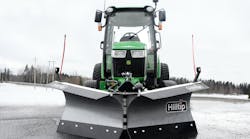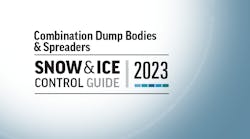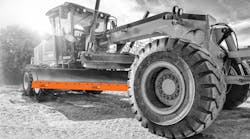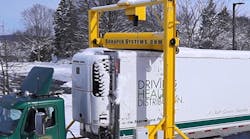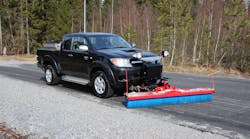Over the Past few years, fleets have expressed their unhappiness and concern over the corrosion that has ravaged their trucks and trailers.
Vern Caron, chairman of the Society of Automotive Engineers' Heavy Duty Brake Committee, says that although much of the blame has been placed on the increased use of magnesium chloride, the overall picture is much more complicated than that.
“A lot of the things we used to use for corrosion protection — like cadmium plating and some of the hexavalent chromiums — have been made illegal, and we can't really use oil-based paint, so everybody has had to change to different techniques for corrosion protection,” he says. “Some of them are good methods, but it takes time to work out the kinks. To get familiar with what works takes time. That has made things worse.
“It isn't just that magnesium chloride has been used. In general, just the plain old road salt being used more often is the cause of more emphasis and concern about safety on the roads. There is more salt out there of various types, whether it's sodium chloride or magnesium chloride. The other thing is that people are spending more time on the road. Vehicles are putting on more miles.”
Suppliers have taken the brunt of the criticism from fleets, creating a back-and-forth conversation with no real resolution.
“A lot of fleets are coming to suppliers and saying, ‘Your parts are no good,’ ” Caron says. “Suppliers are kind of stuck. They've said, ‘OK, if these parts are not adequate in terms of corrosion protection, what do you want us to do?’ Of course, the fleets couldn't tell them exactly what to do. They've just said, ‘I don't want it to fail on my vehicle.’ Well, the suppliers couldn't respond to that.”
That may change as soon as November with the publication of J2721, an SAE recommended practice (RP) for validating the acceptable corrosion performance of metallic components and assemblies used in heavy truck, bus, and trailer applications.
Task force set up
The work started three years ago, arising out of Caron's involvement as chairman of the Heavy Duty Brake Committee and the issue of rust jacking. The committee addressed the issue and decided it was something that merited further examination, but quickly realized rust jacking was only part of a much larger issue. Caron approached the SAE's Truck and Bus Council and proposed that it set up a task force and look at compiling a better standard that could be used to verify whether components have good performance against corrosion when they are installed on a vehicle.
The result was a 27-page report that has gone through one ballot and will be published when all 27 committee members approve it on the second ballot.
“We do have a section on vehicle-level testing, but for the most part, the SAE membership involved are component suppliers,” Caron says. “And they want to know, ‘Is my nut or bolt or fender going to perform OK on a vehicle? I can't afford to test the whole vehicle to find that out, so I need ways to do component-level testing.
“This standard says nothing about how you fix the problem. It only is a way to tell you whether you succeeded in fixing the problem once you've come up with your proposed solution to corrosion protection. This is a set of tests you can run to validate the performance of your component. Depending on where it's located and used, there is a test — for the cab, under hood, chassis or wheel end.”
Caron says companies generally have been using the American Society of Testing and Materials' (ASTM) B117 salt test, designed to examine the relative resistance to corrosion of coated and uncoated metallic specimens when exposed to a salt-spray climate at an elevated temperature. Test specimens are placed in an enclosed chamber and exposed to a continuous indirect spray of neutral (pH 6.5 to 7.2) salt-water solution, which falls out onto the specimens at a rate of 1.0 to 2.0 ml/80cm2/hour, in a chamber temperature of over 35 degrees C.
He says that it was intended to be a 96-hour test, but companies were going up to 500 hours and still not getting the results they expected to get in terms of correlating with old performances.
“We needed to look at test procedures that were going to be more representative of what you see in the field,” he says. “So we looked at cyclical corrosion tests and the old GMC 9540P standard that has now become obsolete because it's labor intensive, and I don't think GM wanted to support it anymore. But we looked at it and said, ‘Hey, there are a lot of good things in here,’ so we kind of adapted some of the thinking out of 9540P. There is one SAE standard, J2334, that is called, unfortunately, a cosmetic corrosion lab test but is good for more than cosmetic corrosion. What's different is that we've introduced different chemicals and chemical mixes that use magnesium chloride and not just sodium chloride, as some of these standards make use of. We increased the available usage of what we call corrosion ‘cocktail mixes’.”
Caron says J2721 also includes a procedure for correlation that involves the use of corrosion coupons — 1"×3" strips of cold-rolled steel (1010 or 1008) that are mounted on a vehicle to help determine the corrosive environment in the field.
Corrosion coupons
A rack of eight coupons is weighed and then mounted in a location that's representative of the area of interest on the vehicle. A year later, a coupon is removed, cleaned, and weighed to determine how much metal loss there was.
“Totally unprotected, metal should wear in a linear fashion if the corrosive environment is constant,” Caron says. “We have preliminary data on what it should be. Once it's well-refined, when you want to test a brake shoe, you say, ‘Well, when I put this in my corrosion chamber and run the test, I'm going to put some coupons in there along with the shoe. If I run the test correctly, when I've lost a tenth of a gram of material, that should correspond with a tenth of a gram in the field. If I lose a tenth of a gram in one year, then in the chamber I should lose a tenth of a gram if my test is representative of a one-year test.’ ”
Caron says SAE received help from the Aberdeen Proving Ground and used that data to put charts into J2721 detailing what levels of corrosion should be seen in the field.
“We use it as starting point while we accumulate data on real vehicles,” he says. “We've had a number of fleets volunteer to mount these corrosion coupons on their trucks and then mail them in once in awhile so we can see how bad the corrosion is in the real world, and then we can use that to improve our recommended practice.
“Different areas on vehicles are cited with different test procedures. It's a cyclical test, so there are periods of drying and chemical exposure. In some cases, there is a lot of heat added for wheel-end components. We've added the new chemicals so it's more representative of what's out in the real world.
“At the end, we've added a method for evaluating how well the sample did after you tested them. Depending on how the parts are used, you may be more concerned about cosmetic corrosion. If it's a mirror bracket, then cosmetic corrosion is an issue. Maybe it's a frame rail, and what you are concerned about is structural performance. So we have different levels of evaluating how the components perform. You have to work out between the customer and supplier what the expectation is for performance, and then we have examples of how we evaluate that.”
Caron says he expects the reaction to J2721 to be positive.
“As with any of these SAE specifications standards and RPs, if you don't like it, you don't have to use it,” he says. “It's not like it's a law. It's a case of, ‘Hey, if you want to use it, here's what we recommend. It's an RP.’ And I think it's a good one. It's not going to be perfect. There is a huge amount of variability in the real world. Depending on where you run the vehicle, there is more or less corrosion.
“As people use the document and start running these tests, we'll learn more. Maybe we have to change things. There might be things we need to revise or things that don't work out as we expected. It's a pretty complicated thing. Some of the users will say, ‘This is a hard test to do in some cases. And the results may not be spot-on perfect either, at least initially. But with time, people will get a lot of confidence and comfort level in this standard.”
